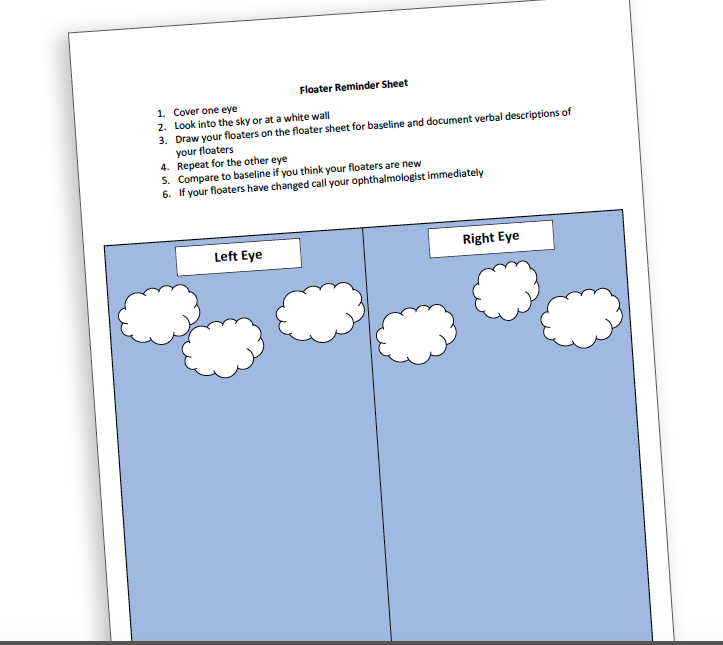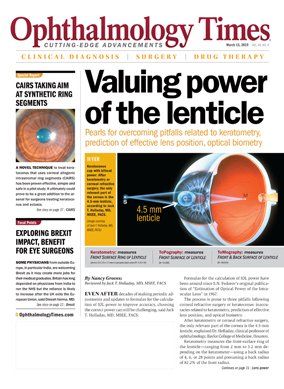Publication
Article
Digital Edition
Letter to the Editor: Ophthalmologist’s experience leads to creation of ‘floater reminder sheet’
Author(s):
Letters to the Editor may be submitted to Sheryl.Stevenson@ubm.com. Letters may be edited for clarity and length.


Letters to the Editor may be submitted to Sheryl.Stevenson@ubm.com. Letters may be edited for clarity and length.
The prevalence of floaters is reported to be 24% in those aged 50 to 59 years, but increases to 87% among those aged 80 to 89 years.1 Floaters can be extremely bothersome and interfere with daily activities, but most importantly, they can be a sign of a retinal tear or detachment especially if acute in onset and accompanied by photopsia.
Twenty years ago, I was pitching Wiffle balls to my younger son, Ryan, and unfortunately, did not follow the advice I give my patients regarding protective eyewear. I did not realize how hard a three-year-old could hit a Wiffle ball with an oversized bat, and I was struck at close range just below the left eye by the batted ball.
The next day, I developed floaters unaccompanied by photopsia in my left eye, but they were subtle, and like a typical physician I ignored them for a few days. I finally saw a dear friend of mine, a retina specialist, and was diagnosed with an inferior horseshoe tear.
I was treated with laser photocoagulation and subsequently developed two more retinal tears which were also treated. My retina specialist and friend told me to call him immediately if I noted any increase in floaters or if I developed photopsia and offered to charter a private plane and fly into see me immediately as he was leaving on a golf trip!
The problem was even though I give these same retinal detachment warnings to all of my patients who present with floaters, I realized it is extremely difficult to know as these black bugs are constantly whizzing by while you are driving or even examining patients if they are new.
I must admit I was nervous for several months after the incident regarding missing new symptoms and developing a retinal detachment. I found myself making drawings and written descriptions of my floaters and constantly checking my left eye by looking into the blue sky (with my right eye closed) where my floaters were most apparent and compared these findings with my drawings and notes. I found these drawings to be extremely helpful and gave me great peace of mind.
Fast forward 20 years, and I still see intermittent floaters. My older son, Tyler, now a third-year medical student at Rosalind Franklin University of Medicine and Science (Chicago Medical School), plans on becoming an ophthalmologist and is familiar with the Amsler grid and its usefulness in self-monitoring for macular degeneration.
He has noticed me checking myself for new floaters and returning to my drawings and descriptions and has helped me develop what we call the “Floater Reminder Sheet.”
I have found it extremely helpful and I wanted to share my story and our floater reminder sheet with other ophthalmologists so that they can use it with their patients. I am glad to report my retina remains attached and I am relatively asymptomatic and have learned to live with floaters.
For readers interested in receiving the Floater Reminder Sheet for their office, send an e-mail to Tyler.Kaplan@my.rfums.org
Disclosures:
Bruce H. Kaplan, MD Dr. Kaplan is chairman of the department of ophthalmology, Rosalind Franklin University of Medicine and Science in North Chicago, IL
References:
1. Hollands H, Johnson D, Brox AC, Almeida D, Simel DL, Sharma S. Acute-onset floaters and flashes: Is this patient at risk for retinal detachment? JAMA. 2009;302:2243-2249. doi:10.1001/jama.2009.1714

Newsletter
Don’t miss out—get Ophthalmology Times updates on the latest clinical advancements and expert interviews, straight to your inbox.





